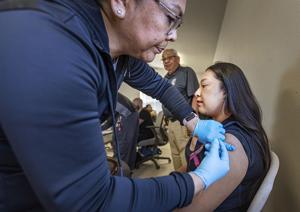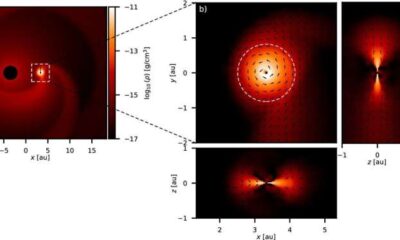Health
New Mexico Seeks Public Input for $50 Billion Rural Health Fund

New Mexico is actively seeking public input on how to allocate federal funds aimed at improving rural health care services. The state Health Care Authority is preparing its application for a share of the newly established Rural Health Transformation Program, which will distribute $50 billion over five years to support rural health care providers nationwide. The deadline for New Mexico’s application is set for November 5, 2023.
During a public forum attended by over 250 health care professionals—including doctors, telehealth developers, paramedics, and hospital executives—participants voiced their priorities for the funding. Key areas identified for improvement included the expansion of behavioral health services, increased resources for mobile and telemedicine, and initiatives focused on the recruitment and retention of healthcare workers.
Dana Flannery, the New Mexico Medicaid Director, noted that the feedback aligns closely with the Health Care Authority’s vision for its grant application. “I’m very excited that a lot of what was stated today aligns with the input we’ve already received,” Flannery said. This consensus suggests that the agency is on the right track as it seeks to enhance rural health care in the state.
The Rural Health Transformation Program was created as part of a federal budget reconciliation law signed by President Donald Trump in July 2023. This legislation, which includes provisions to reduce taxes and discretionary spending through 2034, has raised concerns among some lawmakers about potential cuts to Medicaid impacting rural hospitals. The New Mexico Health Care Authority has estimated that these cuts could lead to the closure of six to eight rural hospitals in the state by 2028.
Funding Allocation and Priorities
The $50 billion in the Rural Health Transformation Program is divided into two parts: $25 billion will be distributed equally among all states, while the remaining $25 billion will be allocated based on each state’s application. While New Mexico’s Health Care Authority is eager to secure a portion of this funding, analysis by the health research organization KFF indicates that the available funds represent only 37% of the losses that rural health providers will face due to anticipated Medicaid spending cuts.
Despite these challenges, health care professionals in New Mexico have proposed a variety of strategies for utilizing the funding effectively. During the meeting, many emphasized the critical need for more health care workers, including nurses, social workers, and specialists like pediatricians, psychiatrists, and cardiologists. These services, while readily available in urban areas like Albuquerque and Santa Fe, are significantly lacking in rural regions.
Dr. Larry Shandler, representing the New Mexico Pediatric Society, advocated for increasing Medicaid reimbursement rates as part of an ongoing effort to attract more healthcare providers to rural areas. Recent rate increases for behavioral health, primary care, and maternal and child health are steps in this direction. “We’re seeing a decrease in health services in rural areas, and one of the ways to build that is to build a better telehealth infrastructure,” Shandler stated.
While telehealth presents a promising solution, some participants expressed concerns about the limitations of internet access in rural communities. According to the Federal Communications Commission, approximately 10% of addresses in New Mexico are considered underserved or unserved in terms of reliable internet connectivity.
Innovative Solutions for Rural Health Challenges
The forum also highlighted the importance of mobile medical resources, including paramedicine and mobile integrated health clinics. Paramedic Faith Applewhite emphasized the role of emergency medical technicians in bridging the gap in healthcare access. “We can really be the boots on the ground to deliver that health care,” she said. “We’re already mobile. We’re already out in communities. We’re already able to access people where they are.”
Flannery underscored that securing grant funding is the first step toward achieving these goals. “Let’s apply and have a very competitive application so that we can bring home this opportunity,” she stated, reflecting the collective optimism among New Mexico’s health care community.
As the Health Care Authority finalizes its application, the input from health professionals will play a crucial role in shaping the future of rural health care in New Mexico. The stakes are high, and the state is poised to leverage this federal investment to address pressing health care needs in its rural populations.
-

 Science2 months ago
Science2 months agoOhio State Study Uncovers Brain Connectivity and Function Links
-

 Politics2 months ago
Politics2 months agoHamas Chief Stresses Disarmament Tied to Occupation’s End
-

 Science1 month ago
Science1 month agoUniversity of Hawaiʻi Joins $25.6M AI Project for Disaster Monitoring
-

 Entertainment2 months ago
Entertainment2 months agoMegan Thee Stallion Exposes Alleged Online Attack by Bots
-

 Science4 weeks ago
Science4 weeks agoALMA Discovers Companion Orbiting Giant Star π 1 Gruis
-

 Science2 months ago
Science2 months agoResearchers Challenge 200-Year-Old Physics Principle with Atomic Engines
-

 Entertainment1 month ago
Entertainment1 month agoPaloma Elsesser Shines at LA Event with Iconic Slicked-Back Bun
-

 World1 month ago
World1 month agoFDA Unveils Plan to Cut Drug Prices and Boost Biosimilars
-

 Business1 month ago
Business1 month agoMotley Fool Wealth Management Reduces Medtronic Holdings by 14.7%
-

 Top Stories2 months ago
Top Stories2 months agoFederal Agents Detain Driver in Addison; Protests Erupt Immediately
-

 Entertainment1 month ago
Entertainment1 month agoBeloved Artist and Community Leader Gloria Rosencrants Passes Away
-

 Science2 months ago
Science2 months agoInnovator Captures Light at 2 Billion Frames Per Second









